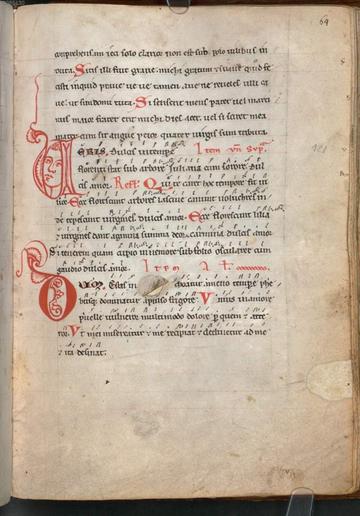New Publication: Revisiting the Codex Buranus
We are delighted to announce the publication of Revisiting the Codex Buranus: Contents, Contexts, Composition, edited by Tristan E. Franklinos & Henry Hope (https://boydellandbrewer.com/revisiting-the-codex-buranus.html), and offer a few thoughts on the volume below. This also seems a suitable moment to say that the editors are hoping to run an interdisciplinary graduate seminar on the Codex Buranus in Trinity 2021—more on this soon.
Contributors: Gundela Bobeth, Charles E. Brewer, Carmen Cardelle de Hartmann, Albrecht Classen, Johann Drumbl, Tristan E. Franklinos, †Peter Godman, Henry Hope, Racha Kirakosian, Heike Sigrid Lammers-Harlander, Jonathan Seelye Martin, Michael Stolz, David A. Traill, Kirsten Yri.
The late Peter Godman’s dictum that ‘no one masters all the skills required by the Carmina Burana’[1] testifies to the complexity of the Codex Buranus and the rich diversity of texts it contains. The manuscript’s hybridity has fascinated and challenged academic and popular audiences since its rediscovery at the Benedictine monastery of Benediktbeuern (from which it takes its name) in 1803.
First edited by Johann Andreas Schmeller in 1847, the Codex Buranus defies attempts at scholarly taxonomy, and debate about the manuscript’s provenance continues to loom large. A compilation date of ~1230 is now commonly accepted for the Codex Buranus; of the possible locations suggested for its creation, Brixen’s cathedral (and its affiliated school) and the nearby Augustinian monastery of Neustift seem to be the most likely candidates. Though this cathedral and monastery were closely connected in the Middle Ages and should not be seen as entirely distinct contexts, the differences between these institutions is highlighted by, and indicative of, the hybridity of the manuscript’s contents:
- mostly written in Latin, the Codex Buranus includes a significant corpus of German texts (as well as short passages in other vernacular languages);
- offering texts by some of the most popular authors of its day—Walter of Châtillon, Philip the Chancellor, Walther von der Vogelweide, and others—the majority of the Codex Buranus is constituted of unique materials, some of which may have been composed in the context of the collection’s production;
- lyric songs are interspersed with metrical uersus and occasional prose texts, while the manuscript concludes with a group of liturgical plays;
- highly sophisticated poetry which bespeaks a familiarity with a range of earlier and contemporary literary cultures sits alongside texts which are often thought of as less skilfully executed;
- largely unnotated, the Codex Buranus contains monophonic melodies in adiastematic neumes; some have concordances in the ‘central’ corpus of French polyphony, while others are unique;
- commending the indulgent lifestyle of (carnal) love and worldly pleasures—made famous by Carl Orff’s setting of some of the Carmina Burana—the manuscript nevertheless voices acerbic criticism of wanton frivolity and, in its plays, draws attention to the ethical imperatives of the Bible;
- many of the texts denigrate women as objects of violent sexual desire, while others are sympathetic to the emergence of a female voice and identity.
Given the diversity and apparent disjunction of its contents, it is perhaps unsurprising that no single scholar has attempted to offer a comprehensive, book-length study of the Codex Buranus. Interdisciplinary, intercultural exchange is as crucial to the manuscript’s scholarly rediscovery as it was to its inception and production—and it is such dialogue that Revisiting the Codex Buranus seeks to model.
Revisiting the Codex Buranus presents a collaborative exploration of the manuscript from a variety of perspectives, (re)considering the context of its production, the composition of its texts, and the interpretation—medieval and modern—of its contents. For the first time, the intra-disciplinary discourses of medieval Latinists, Germanists, and musicologists are brought into conversation with one another. This kaleidoscope of approaches not only provides a resumé of previous scholarly enquiry into the Codex Buranus within a single volume, but allows for a new appreciation of the manuscript’s unique complexity. The volume hopes to become the starting point for renewed interest in the Codex Buranus, seeking to facilitate further study by the provision of comprehensive tabular overviews of the manuscript’s contents and of the extent of its notation.
Undoubtedly, authors and editors of Revisiting the Codex Buranus can make no claim to have mastered all skills required for the study of the Codex Buranus—nor does the volume intend to provide any such definitive assessment of the manuscript. Instead, it is hoped that it will facilitate and inspire further collaborative exploration of the manuscript’s rich complexity and encourage performers in their continued engagement with the Codex Buranus.
***
About the authors:
Dr Tristan E. Franklinos is a British Academy Postdoctoral Fellow in Classics and Junior Research Fellow at Trinity College, Oxford.
Dr Henry Hope was a Lecturer in Music at Magdalen College and New College, Oxford, before taking up a postdoctoral position at the University of Bern.
1 P. Godman, ‘Rethinking the Carmina Burana (I): The Medieval Context and Modern Reception of the Codex Buranus’, Journal of Medieval and Early Modern Studies 45 (2015), 245–86 [245].
***
For more medieval matters from Oxford, have a look at the website of the Oxford Medieval Studies TORCH Programme and the OMS blog
Munich, Bayerische Staatsbibliothek clm 4660 (Codex Buranus) fol. 64r

Munich, Bayerische Staatsbibliothek clm 4660 (Codex Buranus) fol. 64r


